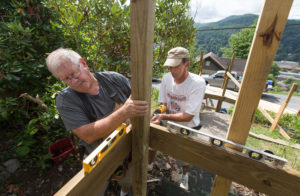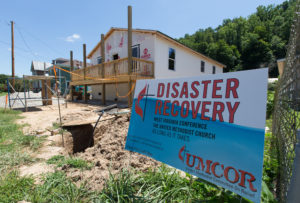Volunteers in Mission teams are indispensable parts of disaster recovery. How’s that for a brilliant opening line? Well, they are. And they bring money for host sites and for construction materials.,
From Maine to North Carolina, from Delaware to Missouri they have come. To date, 70 teams have come, over 100 when counting teams that come back multiple times. Two of our teams, one from Ohio and one from New York, will have been here four times by the end of this summer.

Wayne Davis (left) and the Rev. Russell Lee work to restore access to a home in Richwood, W. Va., that was damaged by runoff from a June 2016 flood. Davis is from Byrd Chapel United Methodist Church in Kents Store, Va., and Lee is pastor of First Presbyterian Church in South Boston, Va. They are part of a volunteer in mission team working with the disaster recovery ministry of the West Virginia Conference of The United Methodist Church. Photo by Mike DuBose, UMNS.
In advance of a team’s arrival, our construction coordinators will have assessed what is needed to repair a home and will see that construction materials and supplies are on site when the team arrives. In some weeks, we have six work teams at the same time, meaning that the coordinators have three teams each to supervise throughout the 12-county disaster region. As this is written, there are three teams housed and working in Richwood. Next week, there are three teams in Clay and Clendenin.
Team sizes range from 5 to over 60. Most have team members with solid construction experience along with lesser experienced or non-skilled helpers. They are generous with their time and hard work. They are equally generous with good spirit in establishing relationships that are lasting with the survivor families with whom they work.
Some teams are project specific. That is, some are highly skilled in carpentry and can frame a house. Some teams have broader skills and can frame, wire, and plumb a new home. One team takes engineering designs for bridges and pre-builds them in Orwigsburg PA, bringing the parts and all the heavy equipment needed to assemble them on site. They have built five bridges in the two times they have come, and we look forward to their return in April 2019.
A key partner in new home construction has been Mennonite Disaster Service which brings teams of volunteers to build houses from the foundation up. In some cases, we need to have footers and foundation in place and they take it from there. We are partnering with MDS on what we are calling a “Church Build” through which Elizabeth Memorial, Christ Church, and St. Mark’s United Methodist Churches in Charleston have provided $66,000 for construction materials for a new home in Kanawha County replacing a family’s home destroyed in the storms and flood disaster of June 2016.

The disaster recovery ministry of the West Virginia Conference of The United Methodist Church hosts volunteer teams from across the country to help survivors of the June 2016 flood restore their homes and lives. Photo by Mike DuBose, UMNS.
With MDS and with other volunteers, we can build a new three-bedroom house for $65,000 though elevation to mitigate for base flood elevation may require additional expense for foundation work.
A World Renew team from Michigan, a mission outreach of The Reformed Church in America, spent three weeks this spring building a home for a survivor in Richwood. A team from Lithopolis, OH brought with them over $21,000 generated from an alternative Christmas project the church conducts every year in which church members make family donations to mission rather than spending money on each other.
Our bishop and cabinet spent a week last summer working on recovery projects in Nicholas and Greenbrier Counties.
A team this spring went home to tell their story of their work with us, and their church sent an additional $12, 000 to be used in recovery work.
Our disaster recovery team comprised of VIM coordinator, disaster response directors, case managers, construction coordinators, and disaster ministry directors try to schedule a day each month in direct construction activity with a survivor family.
We ask volunteer teams to bring with them $5.00 per person per day for the host site to help with utilities, paper products, and other expenses involved in hosting work teams. And we ask them to bring $100 per person to help with construction materials and supplies. Some are unable to bring those funds, but they are told we need the volunteer help more than the money. Others bring substantially more funding to assist with recovery. We tease, though there is truth in it, that “We need you to volunteer, and we want you to pay to get to do it.” Our teams know they need to be self-sustaining while here and do not add stress to already-challenged local resources., It may seem cliched to say, but we could not accomplish all that we do without our wonderful volunteers.
Thank you, thank you, thank you!
John W. (Jack) Lipphardt, one of the New Vision with Hope Disaster Response Coordinators. He may be reached via email at: jwlipphardt@aol.com.